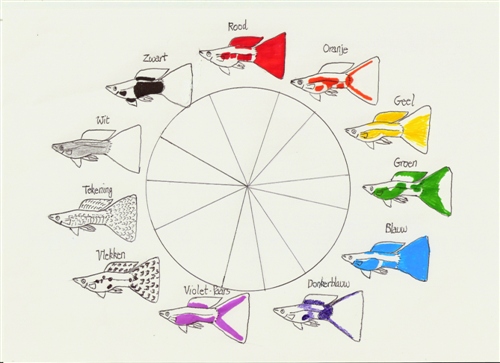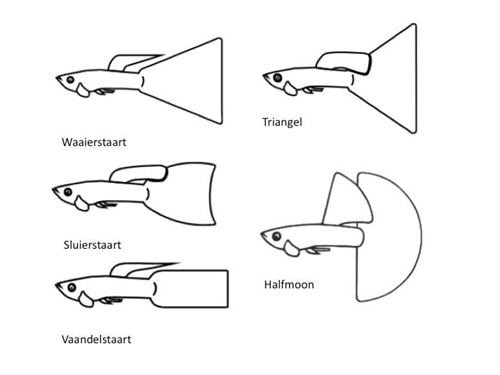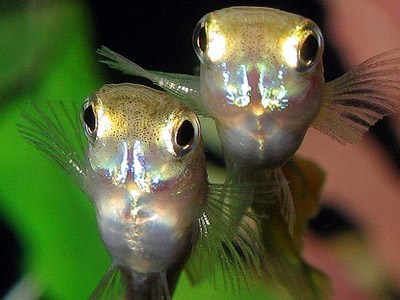Art VIII
Message from the Guppies
RUBRIEK: Guppy Kweek English Translation


There are 3 groups that "deal" with guppies. First of all, there are the gup-py breeders, who, because of the guppy is a tropical fish, are mainly located in the "tropical belt" (South East Asia, Central America, .....). There, gup-pies are bred in great numbers in containers in which they sit by hundreds at a time, with ventilation and water change, but most of the times without plants (like the trout farms here). These are used for export to all parts of the world, are rarely fully grown when that happens, die for about 40% du-ring shipment to major importers, and eventually end up in the aqua-riums , via a short stoppover in an aquarium shop, in the living rooms of those who have (still) an aquarium.
The second lot, is the "Academic environment": because the Lebistes reticulata (formerly) or poecilia reticulata (present) is an interesting study object due to its color and caudal fin variability, its hereditary material is scientifically investigated by the geneticists, with all the rules (and there-fore limitations, but these are usually not mentioned) that scientific re-search must correspond to. This usually concerns wild-caught specimens, because they function in their natural habitat according to the laws of na-ture, and because the hereditary material varies within limited, thus regis-trable and recognizable parameters.
And last but certainly not least, there are the guppy clubs: enthusiasts who breed guppies and unite in clubs that regularly hold exhibitions with gup-pies of their members' , and where jury members award prizes to the "most beautiful guppies". These "beautiful guppies" must accord to specific stan-dards set by the International Guppy FederationS (as in the boxing world, there are several). Given the variability and the rapid reproduction (also in aquariums, where the laws of nature are less effective), and there was a real proliferation of all kinds of shapes and colors, they tried to mannage that process in the right tracks, by introducing standards : guidelines which mainly related to the shape of the caudal fin. And as more and more patterns were cultivated, a division into types was necessary.

Man has the ugly habit of seeing himself as the center and measure of the world, and so he refuses to see that there is another, fourth party involved here: we, the guppies themselves . That's why we've asked our friend here to represent us: he's been involved with guppies from childhood, his understanding of genetics and nature goes deeper than most, and he's not too shy to look at things, as they are. We have thus asked him to give the following messages to the other parties involved:
MESSAGE TO THE GUPPY BREEDERS
Agreed, everyone must live, and in itself we have nothing against being sold as "merchandise", but growing up in real concentration camps is not a sign of respect and a lot over the limits. Wherever we occur in the wild, we also serve humans by getting rid of those nuisance mosquitoes. In return, may we please ask to be housed in a somewhat normal way? In the West people complain that chickens in batteries and pigs in narrow stalls have to live in degrading (!!) situations. Is it too much to ask from us then, to give us some aquatic plants, and not to stuff ourselves like sardines in a can? Our thanks for that, and also thanks for the free food.

MESSAGE TO THE GENETICISTS
You are real bright minds and the technology allows you to associate cer-tain traits with certain genes and mark them in their locations on the DNA strands. You think you can define and determine everything with this, but we must bring you bad news: that is the illusion of science. Likewise, for example, you can map out the locations of brain activity, but the REAL work - communicating the neurons with each other - eludes you, and you can only write it down. Well, the same thing happens with genes: they do not work separately and independently of each other, but on the contrary interact with each other from the whole that is an individual.
And thus simple realities of practice can escape you, such as this one: with us guppies, colors and patterns are divided into horizontal and vertical zo-nes. That may not be noticeable with wild guppies, due to their enormous diversity, but when one starts to distribute our gene material according to types instead of letting it fused back into the large gene pool as it happens in nature, it should still stand out what "order" there is in that apparent chaos. Second example: we have preferred locations for our numerous colors (see figure above). A third and final example: you can label until the sun sets, but for ALL animals applies this reality: you cannot cram all the properties into one animal. What therefore applies to the dog (and with these "friends" you have been "commuting" for centuries), and to humans (yes), also applies to the gup. One cannot get everything in life, but one has to make choices. To give just one concrete example of this: our biggest brothers are also the males with the least color.

MESSAGE TO THE GUPPYCLUBS
And so we arrive at our message for the next group in one swimming stro-ke. Guppy clubs are running high with us. At least, as long as they can win prizes with us. That again reminds us of those other "best friends" of man: when greyhounds no longer win prizes, they will be thrown out like waste. We guppies are treated in the same way: we meet the expectations of our boss! Then we are put in a golden cage and as prize animals we get all the privileges reserved to our noble stand. But oh woe, if our owner thinks that we are only good for the "rubbish bin", tabee preferential treatment! The surprising thing is that the fish that are chosen for this are often real suc-kers by our guppy standards, who could hardly survive in the wild for 5 mi-nutes. Or great ugly ones, because bizarrely enough people in those guppy clubs have an obsession with "tailperfektion" and they have a 10 Com-mandments about this with their standards (see figure above), but less eye for what is our main quality : our richness of colors.
These "lovers" may mean it well, but do they actually love us? We wonder, because they constantly look at us with a scrutining or disapproving look. Where did the time go when they, as children, could take up their positions in front of the aquarium for hours, enjoying the play of colors as we swam past. Because it gave them such pleasure, we gave an extra, free show. But on those guppy shows it is going extremely serious: we have to give show performances, whether we feel like it or not. We are dropped in plastic bags and moved from here to there. Such a showroom is also not a nice place: we end up in a bare container, so that people can see us better, and we have no privacy at all.

And do they actually know us, controlled as they are with their own expec-tations? Do they know that in the wild we swim together in schools of animals of all ages? The big females at the center; courted, of course, by the big males on the sides of it. The little ones at the top, and the juveniles at the bottom. And do you know why males in the wild do grow up in such mixed company? Because they also want to court the large females, but are chased back by the males. Only when they get their colors can they compe-te with the males, and they can move up a rank. Nobody is really interested in the growing females, although one can always expect that there will be one pregnant too soon. Doesn't that happen to humans too?
The requirements of the guppy club members also contain a number of im-possible expectations: for example, that we guppies could have beautifully grown fan tail fins AND brilliant colors. As we have already explained to the geneticists: it is one OR the other. So one has to choose what his priori-ty is. What can be done is to breed guppies with LESS grown state fin, and still beautiful colors. Then one seeks a balance between the two. Did you know that some guppy lovers who are not guppy club members sometimes shorten our overly long fintails to make us live longer and make our swim-ming easier? After all, we have to keep the whole trade with us all the time. And it is also time for guppy club members to understand that they are contributing to color depletion by breeding types with fixed genomes. Usually they give them roaring names, such as tuxedo, Japan blue, metal-head, Moscow, ... and because these pieces are inherited unaltered, it is easier for them to cultivate. But we guppies, how many brothers don't seem like they are glued together from two or more pieces? Sometimes we look like clowns with fluent and glaring colors next to each other! Nature never allows such ugly combinations. May we preserve our dignity, please, and not fall victim to man's lack of taste or excess ego ambition? Thank you.
Signed: the guppies.
